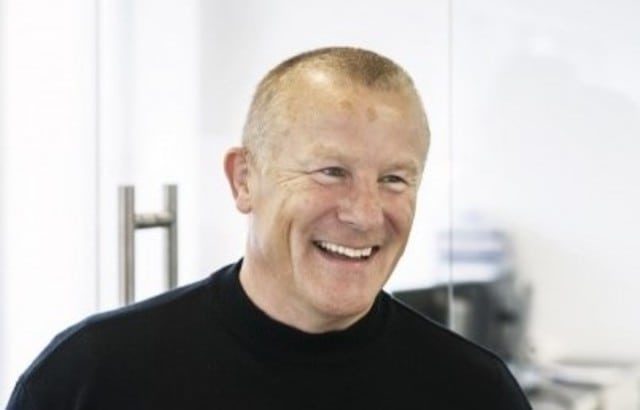Shares in the subprime lender collapsed the instant the market opened, dropping more than 70% on the day and wiping £1.75bn off its market cap.
Shortly after, it was ousted from the FTSE 100. But it was an especially grisly day for shareholders Neil Woodford and his former colleague Mark Barnett, head of UK equities at Invesco Perpetual, who at the time owned 19.9% and 20.17%, respectively.
Woodford lost about £300m on the day, while Barnett’s losses were reportedly closer to £400m. As is to be expected of someone with Woodford’s star power, and who runs such a staggering amount of money, shareholders demanded an explanation and a mea culpa moment.
At the time, the heavyweight manager admitted to being “hugely disappointed” by what had happened, but continued to defend his controversial holding in the battered credit company, even going so far as to predict the century-old business “will be around for many decades to come”.
Later, the Woodford press team published a series of Q&A-style videos on the firm’s website as part of a new segment called ‘Awkward Corner’, where the notoriously elusive manager tackles the most uncomfortable questions he gets asked by his fiercest critics: investors and IFAs. After dealing with the delicately worded, “Has Woodford lost it?”, he turned his attention to another oft-asked question: “Do you need to own such large stakes in companies?”
What’s at stake?
Woodford and Barnett, who manages the £33bn income strategies Woodford formerly ran for Invesco Perpetual, both hold a number of sizeable stakes in listed and unlisted companies across their funds.
Owning so many substantial stakes in firms is not so commonplace in the open-ended fund industry, but Woodford insists it is part of his high conviction value strategy.
Staring down the lens of the camera, he said: “For my entire career I have owned large stakes in businesses and we have invested in small businesses, too. That is the natural approach of an active manager who is doing something different from the index. By definition, you’re going to own a portfolio that does not look like the index.
“Of course, that strategy is called into question when performance is not good, which it hasn’t been for the past two years. But it is absolutely the case that in optimising the portfolio, and in capturing the best economic opportunities, I need to own significant stakes in businesses both small and large.”
For Woodford, the practice of owning so many significant stakes in investee companies is an active share issue, which investors should appreciate in an era of closet tracker funds. By his own admission, it is clear he considers the practice of owning such high-conviction stakes as a necessary component in the current economic climate.
Woodford has made a name for himself by backing smaller start-ups and eschewing many of the mainstream mega-cap names and big dividend yielders that populate most equity income portfolios. His nearly £9bn equity income fund currently contains only nine FTSE 100 stocks out of 133 holdings. By contrast, he has 44 unquoted companies in the portfolio of his flagship fund, accounting for 9.36% of his total holdings.
His successor at Invesco Perpetual, Barnett, holds many of the same mega stakes, including Boston-based intellectual property firm Allied Minds, which also ran into trouble this year, the gene-editing company Horizon Discovery Group and the digital media business Brave Bison.
Barnett has made the Invesco Perpetual income strategies his own, however, hanging on to British American Tobacco, which Woodford abandoned, and recently buying oil giant BP, also not owned by Woodford.
Likewise, Woodford is a major shareholder in companies Barnett is currently not invested in, such as Purple Bricks Holding, of which he owns 27.05%, or 73.5 million shares.
Taken to task
Invesco Perpetual has faced the wrath of the UK regulator for breaching investment limits before. The asset manager was fined £18.6m by the FCA in April 2014, weeks after Woodford’s departure, for flouting rules on investment limits designed to minimise clients’ exposure a total of 33 times between 2008 and 2012.
Invesco Perpetual agreed to pay £5m in compensation to the funds that were affected by the improper trades, which they later identified as the Invesco Perpetual Income and High Income funds, previously run by Woodford, and Nick Mustoe’s Managed Income Fund.
Both Woodford and Barnett’s stakes in Provident Financial, now 19.99% and 20.75%, are within the constraints of the UK’s takeover code, which states that if a company owns between 30% and 50% of the shares in another company, it must make an offer to purchase the remaining shares. However, together, the pair owns more than 40% of the company.
Given the large proportion of shares he owns, could Woodford have sold out of his investment even if he wanted to on the day that Provident Financial’s shares came crashing down? And what if his fund or Barnett’s £5.3bn Invesco Perpetual Income or £10.6bn High Income funds suffered mass redemptions on the day?
Would the funds be able to cope, or would investors who were slower to react find themselves without an exit route?
Ridding yourself of shares in a company the size of pharma giant Astrazeneca, currently the largest holding in Woodford’s flagship equity income fund, at 8.63%, is a far easier task than trying to ditch your shares in a firm that is 19 times smaller, like Provident Financial.
On the day of Provident Financial’s second profit warning, the average daily volume (ADV) of PFG was about 555,000 shares per day over two years. Theoretically, if Woodford wanted to sell down his exposure to the sub-prime lender it would take him at least 54 days, selling 555,000 shares or 100% of the ADV per day. And the process could conceivably take longer than that if he wanted to take a more cautious approach so as not to upset the share price further.
The difficulty with using the ADV to measure liquidity is that it can be a subjective benchmark. Since 1 September 2017, Provident Financial’s ADV is now 2.2 million shares, thanks to the mania around the selloff. With that start date, it would only take him 12 days to get out.
Liquidity patterns
Measuring liquidity can be tricky, agrees Eoin Murray, head of investment at Hermes Investment Management. While asset managers will typically agree an upper limit, restricting the average volume of shares they can trade per day, he says this is not a foolproof way of skirting liquidity problems.
“The standard practice is that you choose a typical percentage of ADV,” says Murray. “For some firms, it will be 25%. For other firms, 35%. And you work out how long it would take to liquidate x% of a portfolio, assuming you can only trade 25% to 35% volume in a day.
“Our view is that this kind of liquidity pattern is only available in normal market times. When you get a fast-moving market you suddenly find there is no way you can realistically be even 25% of ADV.”
Hermes addresses this problem by stressing those numbers further, to see what would happen if they could only realistically trade 5% of the ADV.
“That gives us a reasonable balance of what happens in extremes if there is a sudden market movement or downturn.”
But Woodford also owns large stakes in even more illiquid companies than Provident Financial, such as Horizon Discovery Group. The volume of HDZ shares traded daily varies widely, shifting from 12,000 all the way up to seven million. A shareholder of Woodford’s current size, at 31.6 million shares, would likely struggle to breakaway within a reasonable timeframe.
As to whether or not Woodford and Barnett were stuck with their Provident Financial holdings, Darius McDermott, managing director of Chelsea Financial Services, says it is difficult to know the motivations, whether they were genuinely stuck or simply in it for the long-haul.
“Only Neil can tell us whether he would have sold if he could. The shares did touch down as low as £4.50 intraday and they have now recovered to as much as £7.60. So, by not panicking, he hasn’t sacrificed that loss of value he would have done if he had been able to sell,” according to McDermott.
But he concedes the size of the stake would have been a problem if he had wanted to sell: “I’m fairly confident he couldn’t have sold his own position in one day without moving the price because of how much of the company he owned.”
Coping mechanism
And, again, if Woodford or Barnett experienced large redemptions on the day, would their funds have been able to cope? If the outflows were too overwhelming, probably not, says Peter Sleep, senior portfolio manager and passives specialist at Seven Investment Management.
“Problems may arise if his redemptions go from a trickle to a steady flow, and if the most liquid, high-yielding stocks are sold first. The first investors out will be fine, but those investors that remain could end up with a different fund to the one they thought they had. They may start out with a high-income fund and could finish up with an illiquid, venture capital fund.
“I think Woodford is aware of the illiquidity issues of some of his investments, and that is why he launched a closed-ended vehicle such as Patient Capital. A closed-ended vehicle is the most appropriate place for larger stakes in companies with little or no trading volume.”
Sleep raises a good point. Is Woodford’s high-conviction, huge stakes strategy and proclivity for illiquid start-ups suitable for an open-ended equity income fund? Has the issue with Provident Financial highlighted a round peg/square hole dynamic, not unlike the one seen after the slew of mega-fund property freeze-ups after the Brexit vote?
Whether or not a fund is ill-suited to a particular investment style “is a complex puzzle” that requires a great deal of thought, says Murray.
“I would be interested in who the other holders are of these unlisted companies, what liquidity there might be in those names and, then, you would want to marry that up with a good understanding of your clients on the other side and what requirements of fund liquidity they might have that would cause you to be a forced seller of these unlisted items.”
McDermott reflects: “Is it appropriate? It is appropriate if they have been as transparent as they have been.”
Woodford has been upfront with investors about the objective of his equity income fund: to deliver positive long-term total returns through a combination of income and capital growth. His strategy permits him to invest 20% of the fund in non-dividend paying assets.
McDermott continues: “Neil believes he will add value to the income fund with those less liquid holdings over time. But if he was to have a substantial redemption, he’s got plenty of his portfolio in very liquid names that he would be able to sell.
“Neil has had a really poor run of a number of stock issues blowing up, which tends to make things more challenging. But he is a patient, long-term investor and generally has a very low turnover. For me, it is another case of buyer beware.”
Invesco Perpetual was contacted for this story but declined to comment.







